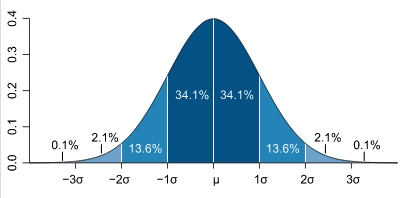Difference between revisions of "Sigma"
(→3 SIGMA - 95% Chance) |
(→1 SIGMA) |
||
| Line 17: | Line 17: | ||
A statistical measurement called "standard deviation" is also referred to as "sigma" on the horizontal axis of a bell curve. Basically, this is a measurement of how much the measurements vary from the center value by a distance of a value called "sigma" on either side of the center of the curve. | A statistical measurement called "standard deviation" is also referred to as "sigma" on the horizontal axis of a bell curve. Basically, this is a measurement of how much the measurements vary from the center value by a distance of a value called "sigma" on either side of the center of the curve. | ||
| − | === 1 SIGMA === | + | === 1 SIGMA - 68% Chance === |
If someone says that an error is 1 sigma, then that person is referring to the greatest possible error in between the lines marked with - 1 sigma to + 1 sigma in the bell curve (see the curve above). Add the percentages of the two regions under the bell to get about 68%. There is a 68% chance that the error will not exceed the value stated. | If someone says that an error is 1 sigma, then that person is referring to the greatest possible error in between the lines marked with - 1 sigma to + 1 sigma in the bell curve (see the curve above). Add the percentages of the two regions under the bell to get about 68%. There is a 68% chance that the error will not exceed the value stated. | ||
Revision as of 00:01, 4 October 2011
|
Most have heard of the "bell curve" in mathematics. This is the shape that describes the probability that a given percentage of measurements will fall within a certain region under a standard bell curve. This shape is found in nature - so its one that mathematicians use often. This shape of the standard bell curve is called "Normal Distribution" or "Gausian Distribution." |
Contents |
HOW SIGMA PERTAINS to the BELL CURVE
A statistical measurement called "standard deviation" is also referred to as "sigma" on the horizontal axis of a bell curve. Basically, this is a measurement of how much the measurements vary from the center value by a distance of a value called "sigma" on either side of the center of the curve.
1 SIGMA - 68% Chance
If someone says that an error is 1 sigma, then that person is referring to the greatest possible error in between the lines marked with - 1 sigma to + 1 sigma in the bell curve (see the curve above). Add the percentages of the two regions under the bell to get about 68%. There is a 68% chance that the error will not exceed the value stated.
2 SIGMA - 95% Chance
If someone says that an error is 2 sigma, then that person is referring to the greatest possible error in between the lines marked with -2 sigma to +2 sigma in the bell curve (see the curve above). Add the percentages of the four regions under the bell between the - and + sigma lines to get about 95%. There is a 95% chance that the error will not exceed the value stated.
3 SIGMA - 99.6% Chance
If someone says that an error is 3 sigma, then that person is referring to the greatest possible error in between the lines marked with -3 sigma to +3 sigma in the bell curve (see the curve above). Add the percentages of the six regions under the bell to get over 99%. There is a 99.6% chance that the error will not exceed the value stated.
WHY is 2 SIGMA used in VTube-LASER?
The 2 Sigma value is used quite a bit for measuring. For example, when VTube-LASER reports Cylinder Fit errors, it always shows the values 2 sigma or (2 times the sigma) value calculated. This lets you know there is a 95% chance that the error or deviation reported in the Cylinder Fit window will not exceed that value.
